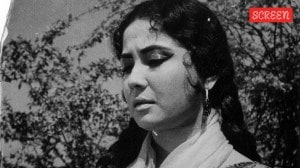Click for more updates and latest Hollywood News along with Bollywood and Entertainment updates. Also get latest news and top headlines from India and around the World at The Indian Express.
Real-life story behind Fountain Of Youth: From Gilgamesh to Florida, the myth that inspired Guy Ritchie’s new movie
Guy Ritchie's new movie follows siblings chasing clues to the mythical Fountain of Youth, a legend rooted in ancient myths from Mesopotamia to Florida.
 Ancient myths inspire Guy Ritchie’s new adventure: The Fountain Of Youth
Ancient myths inspire Guy Ritchie’s new adventure: The Fountain Of YouthGuy Ritchie’s new Apple TV+ movie Fountain Of Youth stars John Krasinski and Natalie Portman as the adventurous siblings fighting, bickering, and finding their way as they hunt down clues in search of the actual Fountain of Youth, a mythical source of water that can keep you young forever or supposedly gives eternal life. While the story seems like a work of fiction, given all the extravaganzas shown, from 9th-century Tibetan scrolls to old glamour, secret symbols engraved in Caravaggio and Rembrandt pieces, lesser known is the fact that it comes from an actual belief that has been continuing from around 2100 BC in Iraq to present-day Florida.
The truth behind the Fountain of Youth
In the film, John Krasinski plays Luke Purdue, someone who steals art, but not for money. Chasing hidden clues in famous paintings is his passion, and most of that interest comes from his late dad, who was a famous archaeologist. In the process, Luke reconciles with his estranged sister Charlotte (Natalie Portman), who works as a museum curator and wants a normal life, until Luke wants her to join the family’s treasure-hunting escapade. Amid a messy divorce and custody battle, she has no choice but to hit the road with her brother, travelling in luxurious cars, bankrolled by a billionaire named Owen Carver, who is desperate to drink the water.
According to The Hollywood Reporter, the story is indeed inspired by a very ancient myth that still holds ground in some parts of the world, all the way back to Mesopotamia (modern-day Iraq). A book written around 2100 BC, The Epic of Gilgamesh, tells a story that has long fascinated the world. It suggests there’s a plant under the sea that makes people young again. From there, you see similar ideas taking birth all around the globe. A Chinese emperor, Qin Shi Huang, ordered his people to find eternal life potions. The Greeks had their own version, golden apples guarded by the Hesperides. Even Alexander the Great is said to have wanted to explore India in search of the waters of life. And not to forget the French woman who drank gold, thinking that would keep her alive.
But the version that stuck with the modern world came from the 1500s, when Spanish explorers landed in the Americas. It is believed that in 1516, an Italian historian whispered about a secret island in the Bahamas with a spring that made old people young again, into a pope’s ear. The next thing we knew was that Spanish explorer Juan Ponce de León sailed off to Florida in 1513, hoping to find it. He didn’t, but the legend exploded among the natives, and soon the search for the fountain was underway. But, turned out Juan was not in search of water, but gold and land. Historians now think the “fountain of youth” tale was made to mock his death.
Also read: The elusive fountain of youth and why so many people are obsessed with age
Still, Florida ran with the myth. St. Augustine claimed that the town had the “real” fountain. There’s even an hourglass-shaped sinkhole in Sarasota County, Warm Mineral Springs, that people say might be the real deal. The water in this 240-foot-wide spring bubbles up from 7,000 feet underground with 51 minerals and maintains a 37-degree temperature throughout. People swear by its magical healing powers, saying it can cure anything from stress and back pain to heart issues. The outlet underlined how researchers found traces of bones from 10,000 years ago and tiger remains, suggesting the place might have been a sacred burial site long before Europeans showed up. But whether the actual myth of the fountain exists, there is no official confirmation. Historians and poets romanticised it in their writings, and soon the myth became a way to hype exploration and attract money and settlers.


Photos



- 01
- 02
- 03
- 04
- 05




























